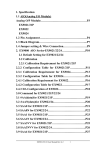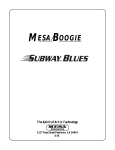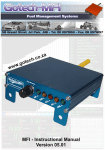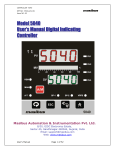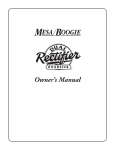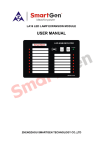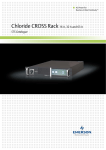Download LED Tank Guage User Manual V3
Transcript
LED Tank Gauge User Manual V3 Product of: E & S Engineering, South Africa Web: www.eandsengineering.co.za Features: • • • • • • • Can be connected to most sender units that have a variable resistance type output between 0 and 250 Ohms. However the smaller the output range the less accurate. Senders using 0 ohm as empty or 0 ohm as full can be used. Exact empty, reserve, half and full levels are saved using jumpers to fit any shaped tank. LED Tank Gauge Circuit uses 13 LEDs to display the fuel level in bar graph mode or dot mode. LEDs flash when in reserve. You can build your own LED layout using the instructions in this manual or request an additional display. LED display board can be used with empty and full set on the left or right of the display. Installation: The installation is pretty easy and not much electrical knowledge is needed. Connecting up power (red and black wire): Red as (+12V), Black as (-). The positive (+12V) wire must be fused in case of a fault and must be connected via a key so that it has power when the car key is turned on. Or any other power terminal that has power when the unit is wanted on, i.e. via a switch or something. The negative (-) can be connected to any ground point. LED Display Dim (purple wire): This purple wire needs to be wired up if you want the LED display to dim when the rest of your instrument's backlights are on. ie at night. The purple cable needs to be wired to a point that will have +12V when the dash lights are on. You should be able to find a connection without to much hassle, just test around with a millimeter. The headlight / dash light switch should have point you could connect to . If you don't want the display to dim you can just leave the cable disconnected, but make sure it doesn't touch anything. Connecting the Sender Unit (white and white with black stripe wire): The sender unit must have a variable resistance output. It must have a range between 0Ώ up to 250Ohms. You can use senders with output range anywhere between these two values, however senders with very small ranges in comparison to 0 Ώ to 250 Ώ will have a less accurate reading on the circuit. You can also use senders with a higher maximum resistance by using an added resistor in parallel with the senders output. However using a sender with a maximum output more that 800 Ώ is not recommended either as accuracy will be low. Refer to the diagram at the end of the manual for more info on this. Please contact us if you are wanting to use senders with other ranges and we can assemble a unit to your senders specifications. With the sender cable, connect the ground wire (white with black stripe) to the common of the sender unit (usually connected to the chassis of the car) and the other sender input wire (white) to the output of the sender. Please refer to the diagrams at the end of the manual for more info on this. Creating your own LED Display Board: If you choose to make your own LED display board to arrange the LEDs in shape and with any colours you'd like, you can. You will need a 14 core ribbon cable and plug (the cable and plug will be included in your parcel if you ordered this option) and 13 LEDs of any colour, standard or bright. You should not need any external resistors in your display unless the LEDs you want to use use more current than most or you are wanting to use more than 1 Led per segment. To be safe each of the 14 cores should not supply more than 15mA each so when all 13 segments are on the unit will not need to supply 200mA or more as this could damage the unit. You could get away with using brighter LEDs that use up to 25mA but then you must not use the unit in Bar Mode only in Dot mode so one LED segment is lit at a single time. Use a millimeter to test how much your LED / LED's are using. The ribbon cable's strand1 (connected to Pin1 of the plug) will have a red stripe on it, this is the 5V + supply. Then next strand (strand 2) is the negative for LED 13 the next strand is LED 12 and so on until the last strand (strand 14) is LED 1. See wiring diagram at the end of the manual for more details on wiring up your display. It is possible to get the circuit to drive a booster circuit if you want to use LEDs or groups of LEDs per segment that will use more current that the circuit will be able to supply, please contact us for more info on this. LEDs 1 to 4 are in the reserve range and will flash, LED 7 is the half full mark and LED 13 is the full mark. Connecting the LED Display Board: The LED board connects to the main circuit using a 14 pin header plug. Pin 1 (which has an arrow on the plug and/or the red stripe on the cable strand goes to left hand side of the main circuits plug where it says Pin1. See Wiring diagram at the end of the manual for more. Saving Settings to memory (using jumpers): When setting jumpers and powering on the device, please check that 1 LED is lit if you placed 1 jumper and 2 LEDs are lit if you placed 2 jumpers. This is to check that the jumpers are making contact correctly. • Setting unit to Dot Mode – (Default) - turn off the key (so unit does not have power). Set jumpers on pins 1 and 2, then turn on the key, now wait until the 1 LED flashes. Then turn off key and remove jumpers and place them back in their default position. All done. . . • Setting unit to Bar Mode – turn off the key (so unit does not have power). Set jumpers on pins 1 and 3, then turn on the key, now wait until the 1 LED flashes. Then turn off the key and remove jumpers and place them back in their default position. All done. . . • Setting unit to 0Ώs as Empty – (Default) - This means that when the tank is empty the sender unit is at its lowest resistance (close to 0Ω) and when it is the tank is full the sender unit is at its highest resistance. - To do this turn off the key (so unit does not have power). Set jumpers on pins 2 and 3, then turn on the key, now wait until the 1 LED flashes. Then turn off the key and remove jumpers and place them back in their default position. All done. . . • Setting unit to 0Ώs as Full – This means that when the tank is empty the sender unit is at its highest resistance and when the sender is full it is at its lowest resistance (close to 0Ω). - To do this turn off the key (so unit does not have power). Set jumpers on pins 2 and 4, then turn on the key, now wait until the 1 LED flashes. Then turn off the key and remove jumpers and place them back in their default position. All done. . . • Setting unit to show LED 1 as Empty – (Default) -This sets LED1 (of strand 14), the strand on the ribbon cable opposite the strand with the red stripe to be the empty LED and LED 13 (strand 2) to be the full LED. See the diagram at the end of the manual for more info. - To do this turn off the key (so unit does not have power). Set jumpers on pins 4 and 1, then turn on the key, now wait until the 1 LED flashes. Then turn off the key and remove jumpers and place them back in their default position. All done. . . • Setting unit to show LED 1 as Full – This sets LED1 (of strand 14), the strand on the ribbon cable opposite the strand with the red stripe to be the full LED and LED 13 (strand 2) to be the empty LED. See the diagram at the end of the manual for more info. - To do this turn off the key (so unit does not have power). Set jumpers on pins 4 and 3, then turn on the key, now wait until the 1 LED flashes. Then turn off the key and remove jumpers and place them back in their default position. All done. . . • Saving tank levels (ADC Values) Setting the Empty level - To do this turn the key off (so unit does not have power). Empty the tank (or fill it to the level you want to show as Empty) and set a jumper on pin 1 (empty pins pins closest to the ribbon cable). Then turn on the key (power up the unit). LED 1 and LED 10 should come on, wait until LED1 turns off. If LED1 flashes, the level has been saved successfully, you can now turn the key (power) off and remove the jumper from Pin1 and place it back in its default position before turning it back on. If LEDs 1 and 2 blink alternately the level was not saved successfully, turn the key (power) off and try again. Setting the Reserve level - To do this turn the key off (so unit does not have power). Fill the tank to your desired reserve level, set a jumper on Pin2 (reserve pins). Then turn on the key (power up the unit). LED 1 and LED 11 should come on, wait until LED1 turns off. If LED1 flashes, the level has been saved successfully, you can now turn the key (power) off and remove the jumper from Pin2 and place it back in its default position before turning it back on. If LEDs 1 and 2 blink alternately the level was not saved successfully, turn the key (power) off and try again. Setting the Half Full level - To do this turn the key off (so unit does not have power). Fill the tank to your desired half full level, set a jumper on Pin3 (half full pins). Then turn on the key (power up the unit). LED 1 and LED 12 should come on, wait until LED1 turns off. If LED1 flashes, the level has been saved successfully, you can now turn the key (power) off and remove the jumper from Pin3 and place it back in its default position before turning it back on. If LEDs 1 and 2 blink alternately the level was not saved successfully, turn the key (power) off and try again. Setting the Full level - To do this turn the key off (so unit does not have power). Fill the tank to your desired full level, set a jumper on Pin4 (full pins). Then turn on the key (power up the unit). LED 1 and LED 13 should come on, wait until LED1 turns off. If LED1 flashes, the level has been saved successfully, you can now turn the key (power) off and remove the jumper from Pin4 and place it back in its default position before turning it back on. If LEDs 1 and 2 blink alternately the level was not saved successfully, turn the key (power) off and try again. Once all levels are set remove the jumpers and place them in their default positions (on the row of pins furthest from the circuit board), refer to the picture at the end of the manual. Now the fuel gauge is ready to run. When the power is turned on the gauge should run through its start up sequence, where all the LEDs should light then the LEDs should scroll from LED1 to LED13 and back to LED1. If all LEDs are on and the Full LED flashes - the tank level is over the full level. If all LEDs are flashing - either the sender is giving off a ohmage higher than the unit is able to read or the wiring / senders or connections are faulty and should be checked out. For more info and assistance on this and other products please check out our website. www.EandSEngineering.co.za Wiring Diagrams: Circuit Connections and jumper layout Wiring Diagram Wiring of display board Ribbon Cable Wiring Tank Sender unit




